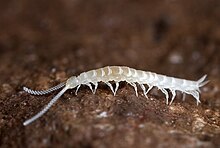| Scutigerellidae Temporal range: Cenomanian–Recent PreꞒ Ꞓ O S D C P T J K Pg N | |
|---|---|

| |
| Scientific classification | |
| Domain: | Eukaryota |
| Kingdom: | Animalia |
| Phylum: | Arthropoda |
| Subphylum: | Myriapoda |
| Class: | Symphyla |
| Family: | Scutigerellidae Bagnall 1913 |
| Genera | |
|
See text | |

Scutigerellidae is a family of pseudocentipedes in the class Symphyla. There are about 5 genera and at least 140 described species in Scutigerellidae.
In this family, the head is distinctly separated from the neck, the antennae usually have more than 20 articles, there are 15 simple tergites, and the first pair of legs is well developed and more than half the length of the next pair. The oldest described species of the family are members of the extant genera Hanseniella and Scutigerella from Eocene aged Baltic amber, undescribed specimens of the family are known from the Cenomanian aged Burmese amber of Myanmar.
Genera
These five genera belong to the family Scutigerellidae:
- Hanseniella Bagnall, 1913
- Millotellina Jupeau, 1954
- Scolopendrelloides Bagnall, 1913
- Scopoliella Scheller, 1986
- Scutigerella Ryder, 1882
References
- "Scutigerellidae". GBIF. Retrieved 2023-05-17.
- "Scutigerellidae Bagnall 1913". Catalogue of Life. Retrieved 2023-05-17.
- Szucsich, Nikola; Scheller, Ulf (2011). "Symphyla". In Minelli, Alessandro (ed.). The Myriapoda. Volume 1. Leiden: Brill. pp. 445–466. ISBN 978-90-04-18826-6. OCLC 812207443.
- U. Scheller. 2004. Two fossil symphylan species, Scutigerella baltica n. sp. and Hanseniella baltica n. sp. (Tracheata, Scutigerellidae), in Baltic amber. Stuttgarter Beiträge zur Naturkunde, Serie B (Geologie und Paläontologie) 351:1-11
- Wesener, Thomas; Moritz, Leif (2018-12-17). "Checklist of the Myriapoda in Cretaceous Burmese amber and a correction of the Myriapoda identified by Zhang (2017)". Check List. 14 (6): 1131–1140. doi:10.15560/14.6.1131. ISSN 1809-127X.
Further reading
- Hansen, H.J. (1903). The genera and species of the order Symphyla. Company of Biologists Limited at the Clarendon Press.
This myriapoda-related article is a stub. You can help Misplaced Pages by expanding it. |